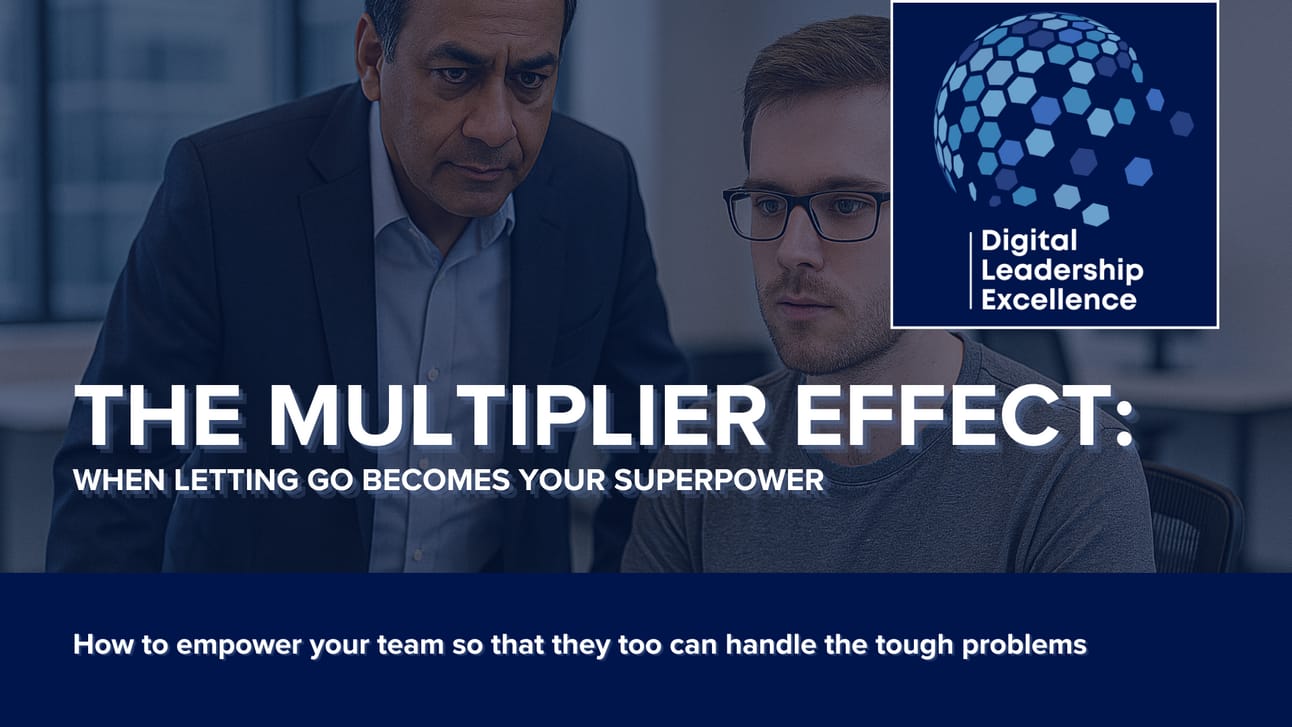Greetings, and welcome to Digital Leadership Excellence—your trusted weekly guide to excelling in tech leadership, delivering results, and thriving with clarity and purpose. In every issue, we provide insights into winning strategies, growth tactics, and practical solutions, designed to support both current and aspiring technology leaders navigating the ever-evolving digital world.
1.0 Introduction
Here's the brutal truth most tech leaders won't admit:
You're accidentally making your team weaker every day.
Not through malice. Through mastery.
Every time you solve the problem they're struggling with, you rob them of growth. Every time you make the decision they could have made, you teach them to wait for you instead of think for themselves.
You've become so good at being the smartest person in the room that you've forgotten how to make everyone else smarter.
2.0 The Smartest Person Trap
Mark was drowning in his own expertise.
VP of Engineering at a Fortune 100 company. Brilliant technical mind. The kind of leader who could debug complex systems in his sleep and architect solutions that made other engineers weep with admiration.
He was also working 70-hour weeks, fielding constant interruptions, and watching his best people leave for "growth opportunities" elsewhere.
"I don't understand," he told me during our first conversation. "I give them everything—guidance, solutions, expertise. Why aren't they happy?"
Because happiness isn't the problem, Mark. Development is.

3.0 The Hidden Cost of Being Indispensable
When you're the smartest person in the room, something insidious happens. Your team stops trying to be smart.
Why would they? You'll figure it out anyway.
They bring you problems instead of solutions. They wait for your architectural decisions instead of developing their own strategic thinking. They've learned that if something gets really challenging, Mark will swoop in and save the day.
You've accidentally created a team of highly skilled... dependents.
Mark's wake-up call came during an exit interview with his most senior developer.
"Why are you leaving? We'll match any offer."
"It's not about money, Mark. I haven't made a meaningful technical decision in two years. You make them all."
That's when Mark realized his superpower had become his kryptonite.
4.0 The Multiplier Mindset Shift
Here's what transformed everything for Mark:

Old Mindset: "My job is to have the right answers."
New Mindset: "My job is to develop people who find the right answers."
Old Mindset: "If I don't do it right, it won't get done right."
New Mindset: "If I always do it, they'll never learn to do it right."
Old Mindset: "I'm valuable because I solve the hardest problems."
New Mindset: "I'm valuable because I create problem-solvers."
This isn't just semantics. It's a fundamental rewiring of how you see leadership.
5.0 The Multiplier Framework
We developed what I call the Multiplier Framework specifically for technical leaders who need to transition from doing to developing.
Phase 1 (Days 1-30): The Release
Start by identifying decisions you make daily that your team could handle. Mark discovered he was making MANY decisions per day that didn't require his expertise level.
Pick five low-risk decisions and hand them over. Yes, your team might choose differently than you would. That's called growth.
Mark started with code review approval processes. Instead of reviewing every pull request, he empowered senior developers to approve routine changes.
Result? Review bottlenecks disappeared. Developer confidence increased. Code quality actually improved because now multiple people felt ownership.
Phase 2 (Days 31-60): The Develop
This is where the magic happens. Instead of jumping in to solve problems, you start asking: "Who on my team could grow from tackling this?"
Mark's turning point came when a complex integration challenge arose. Every instinct screamed "just fix it." Instead, he paired a senior developer with a junior developer and provided guidance from the sidelines.
Three days of struggle. Mark watched, coached, but didn't rescue.
The breakthrough moment? They found a solution he never would have considered. More elegant. More scalable.
That junior developer? Now leads architecture decisions for the entire platform.
Phase 3 (Days 61-90): The Multiply
Now you're not just developing individual contributors. You're developing leaders who develop others.
Mark began including key team members in strategic planning sessions. Client meetings. Architecture discussions. Not as observers, but as contributors.
Suddenly, they understood the business context behind technical decisions. Their code reflected business value, not just technical excellence. They started proposing solutions to problems that hadn't even surfaced yet.
6.0 The Results: From Bottleneck to Force Multiplier
Ninety days after implementing the Multiplier Framework, Mark's transformation was undeniable:
Personal work hours: 70 → 45/50 per week
Team decision-making velocity: 300% increase
Developer retention: 70% → 95%
Innovation proposals from team: Significant increase

But the numbers don't tell the real story.
"I went from having 12 people who waited for my decisions to having 12 strategic partners who challenge my thinking," Mark explained. "They don't just execute my vision anymore. They improve it."
7.0 The Exponential Effect
Here's where letting go becomes a superpower:
One expert (you) can solve X problems and make Y decisions per day.
Twelve experts (your multiplied team) can solve 12X problems and make 12Y decisions per day.
But here's the kicker—they can solve problems you've never encountered and make decisions from perspectives you don't have.
That's not addition. That's multiplication.
8.0 Overcoming the Control Paradox
"But what if they make mistakes? What if quality suffers?"
Mark asked the same questions. Here's how we addressed them:
Start with Reversible Decisions
Amazon's Jeff Bezos talks about Type 1 (irreversible) and Type 2 (reversible) decisions. Start by delegating Type 2 decisions. Build trust and confidence.
Create Learning Loops
When team members make choices different from yours, resist the urge to correct immediately. Ask: "What did we learn? What would we do differently next time?"
Measure Growth, Not Perfection
Track how many decisions your team can make independently. How many problems they solve without escalation. How often they surprise you with insights.
Mark's revelation: "I realized I was optimizing for my comfort instead of their growth."

The Compound Interest of Development
Three months in, something remarkable happened.
Mark's team started developing other people.
His senior developers began mentoring juniors not just in technical skills, but in strategic thinking. They started asking business questions during code reviews. They proposed architecture changes based on user experience, not just system performance.
The multiplication effect had multiplied itself.
9.0 Your 90-Day Challenge
Ready to discover your superpower? Here's your starting point:
Week 1: The Decision Audit
Track every decision you make for five days. Category: Could someone else have made this?
Week 2: The First Release
Pick three decisions from your audit. Hand them over to team members. Resist the urge to course-correct immediately.
Week 3: The Problem Partnership
Next technical challenge that arises? Don't solve it. Partner with a team member to solve it together. Guide, don't do.
Week 4: The Strategic Invitation
Include a team member in one strategic discussion they normally wouldn't attend. Not as an observer—as a contributor.
10.0 The Multiplication Metrics
Track these indicators of your multiplier effect:
Decisions made per day by your team (without you)
Problems solved without escalation to you
Strategic suggestions originating from team members
Time between problem identification and team-generated solutions
Mark's final metric? "I measure my success by how well my team performs when I'm not there."
The Letting Go Paradox
Here's the beautiful irony Mark discovered:
The more control he gave up, the more influence he gained.
The more decisions he delegated, the more strategic he became.
The more he developed others, the more indispensable his leadership became.
"I thought letting go would make me less valuable," he reflected. "Instead, it made me irreplaceable. Because now I'm not just a problem-solver. I'm a multiplier-creator."
Your Multiplier Moment
Every technical leader faces this choice:
Stay the smartest person in the room and cap your impact at your personal capacity.
Or develop the smartest team in the building and multiply your impact exponentially.
Mark chose multiplication. In 90 days, he transformed from a brilliant individual contributor who happened to have a leadership title into a true force multiplier.
His team doesn't just execute his vision anymore.
They exceed it.
That's not management. That's multiplication.
And it starts with the hardest thing for any expert to do:
Let go.
Your team is waiting for you to trust them with greatness.
The question is: Are you ready to discover your superpower?



